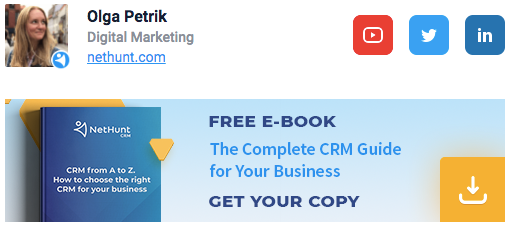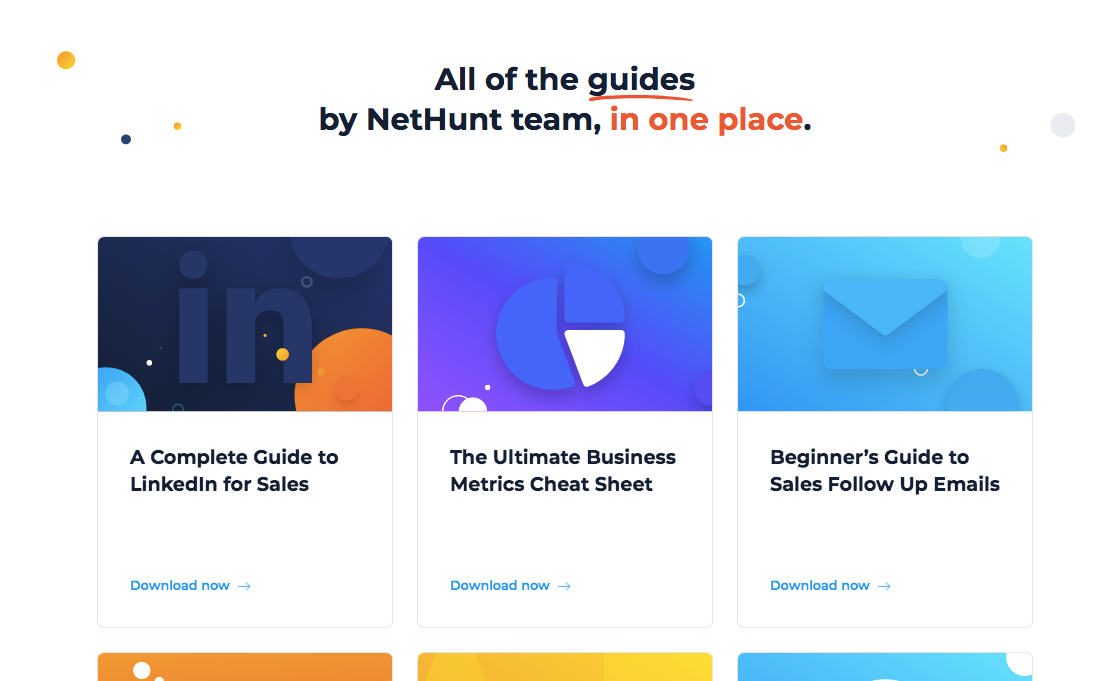Email marketing campaigns have a mindblowing return on investment; the largest out of all the digital marketing channels.
With email marketing, ROI is $40 for every $1 spent.
(Source: WebEngage)
Sounds dreamy. Well, it is a dream. That is, until you have a robust mailing list to shoot your email marketing campaigns to.
Let’s start building one!
What is an email list?
An email list is a collection of all the email addresses of customers and prospects available to your business. It acts as a foundation for all your marketing and sales efforts, allowing the distribution of business materials to target audiences.
There are three types of email list.
- Built email lists. You build a database of contacts by accumulating people who ‘opt-in’ for email campaigns. You own all the data on the list, so the addresses there are ready-made to your business.
- Rented email lists. You don’t own the addresses in the mailing lists. Instead, you get a one-time right to distribute content from a third-party. With rented lists, you do not actually mail your campaigns. You craft a message you want to distribute, and the owner of the list sends it for you.
- Obtained email lists. You buy an existing mailing list from a third-party provider. All the addresses are in your possession, so you can use them multiple times to satisfy marketing needs and conduct your email marketing campaigns. In theory.
In practice, obtained email lists are bad. We’ll cover that later on.
Built email lists vs. Rented email lists: Why does your business need to build an email list?
Both building and renting mailing list methods have their advantages and disadvantages.
Advantages
Disadvantages
Rented mailing lists
High volume
Time-efficient
High rental costs
Lack of targeting precision
Built mailing lists
Precise targeting
No rental costs
Affordable mailing
Higher ROI
Time-consuming
Labour-intensive
Despite the rented lists being less laborious to use, in the long-run, your business will benefit more from building a mailing list of your own. It’s gratifying in terms of saving you a lot of money, resources and allowing making your email marketing campaigns more precisely targeted.
How to build a robust email list
Building an email list is by far your best option. Don’t worry it’s not as difficult as it seems.
Before you start: Things to check off your list
There are thousands of different email list building techniques. Your first job is knowing what you want from your email list. You need to ask yourself these questions beforehand.
- Who would I like to have in my list (buyer persona, target audience, etc.)?
- How would I use it (emails, SMS, calls, etc.)?
- What funnel will I move the contacts through?
- How much time and effort am I willing to dedicate to email list building?
Organisation is key! Before you start acquiring new contacts for your mailing list, ensure that you have the necessary tools and software ready to maximise its productivity. The following three things are must-haves before you build your list.
- A website. All your email list building efforts need to lead to an opt-in web form conveniently built into your website.
- Emailing software. You need to decide on an emailing software to utilise all your newly acquired contacts effectively.
- A reliable CRM system. Save yourself some time and effort of organising contacts, and invest in a CRM system to do the job for you. Preferably... a smart CRM that integrates with Gmail.
Ahem, I think I know a good one. ;)
Mailing list building techniques and ideas
Sorry to break it to you, but all your competitors want the same thing as you -- a big, fat, healthy mailing list -- however...
Only 54% of customers are willing to share their email address with businesses—down from 61% a year before. (Source: Forbes)
Not only are you competing against other businesses for customers’ loyalty, but you also compete for the mere chance to earn it. Today, to grow your list the inbound way, you need to get creative!
There’s loads of mail list building techniques, but you can’t go for higher-class methods if you aren’t all settled with the more obvious ones. A classic is always a classic.
1. Cheeky popups
Dynamic is (almost) always better than static. While popups can sometimes be aggressive, they are usually unobtrusive. You’re just reminding your potential mail list contacts to join if they want.

Make sure you aren’t being obnoxious with your popup webforms and don’t spoil anyone’s experience. Instead, automate a popup to appear when the user is about to leave.
2. Standard opt-in forms
Don’t underestimate the power of standard opt-in forms. Even though they are not creative in any way, they still work! Strategically place an opt-in form on your website, and watch the new subscribers roll in. Guaranteed quality contacts that are genuinely interested in getting updates from you.

3. Get employees involved
Your mailing list building process doesn’t have to be active all the time. You can successfully enrich your list of subscribers passively if you get your employees to cooperate.
Almost all popular email service providers offer email signature customisation with an in-built signature editor. Alternatively, you can HTML-code or design one in a graphic editor to embed it manually.
Put a CTA at the end of every email asking customers to sign up for your mailing list or insert a valid content offer. It’s not aggressive but it gets the job done.

4. Work on providing high-value email marketing letters
Word-of-mouth is a powerful strategy when it comes to acquiring new contacts for your mailing list. You need to captivate your subscribers with content so they’re more inclined to recommend you to their friends and colleagues. Provide engaging and valuable email marketing content, with lots of exclusive materials attached to your letters. Existing subscribers can promote your company by forwarding your marketing letters to their network.
This isn’t only an email list building technique but also an email list decay preventive measure. The more exciting you make your email marketing campaigns and the more attractive they are, then the more people will be looking forward to receiving them.

5. Gamify signup webforms
Gamification is a hot digital marketing trend.
The most effective way to gamify your signup forms is to offer potential email list contacts an exchange: you provide a fun way to obtain a small prize for their sign up. For instance, you could set up a fortune wheel with different discounts, a puzzle or a riddle that needs to be solved to gain access to extra materials such as an e-book or a checklist, etc.
It’s in human nature to be at least a little bit competitive. Games, no matter how simple and subtle, appeal to this wish to gamble. You are much more likely to exchange your email address for something cool! The three core elements of gamification are.
- Engagement;
- Award;
- Competition.
Signup webform gamification has all it takes to attract new subscribers to your mailing list because It’s eye-catching, it’s easy to implement, and it encourages action. It’s a win-win situation for all: the website visitor gets stimulation, and you gain a new contact for your mailing list.
6. Conquer new subscribers with outstanding content offers
You must have noticed how all NetHunt blog posts have a tempting offer in the header — a checklist, a free e-book, a webinar, you name it!
Well, this is something we use to attract new people to join our mailing list.

Bribe people onto your mailing list. Not literally — jail! — but with something commonly known as an ‘ethical bribe’. Gated content, or a lead magnet, refers to additional pieces of valuable information websites are willing to share with new mailing list subscribers.
7. Freebies
No one wants ‘free updates’ as a reward for joining a mailing list. At least not until they’ve made sure your updates are worthy of their time and attention.
Instead, offer a physical discount or freebie, on the other hand. People love free stuff. Even if they don’t need what you’ve got to offer at the time, their interests will be piqued. Whenever they see an offer like that, they’ll automatically consider it just for the sake of doing it.

8. Start blogging
Start a blog of your own if you haven’t already. A large portion of people don't want to sign up to mailing lists because they’re scared their inbox will quickly be filled with endless promotional letters. No one wants an ad when they’re drinking their morning coffee and reading emails.
However, if you do have a blog, you’ve clearly got something a little more valuable than an ad to send. If you don't have it, then it's time to create your own blog.
Stealing is not okay… But borrowing is!
You can start submitting guest posts for other websites with a CTA to subscribe to your mailing list. Unless you run a ‘show-stopping, spectacular, never the same, totally unique, completely never been done before’ business, you likely have a fair share of competitors in your niche. It’s time to exploit them! Team up on mutually agreed terms to write guest posts for their website, borrowing their audience.
9. Embrace tradition
While email marketing is a digital marketing strategy, it doesn’t mean you’re limited to methods of digital marketing. A combination of different methods and techniques drives success. Don’t be afraid to branch out and do something unconventional to get more people on your mailing list.
Arrange an offline (or online, while Corona is still wilding) event that you need to register for. Just make sure you don’t violate General Data Protection Regulation (GDRP) and explicitly tell your audience what you’re collecting their email addresses for.
Dos and Don’ts of building an email list
✔️ DO get a reliable service provider for your mailing list
You want to make sure that all your efforts are fruitful and don’t go to waste just because you haven’t paid enough attention to choosing a good email service provider. The features to look out for in a service provider:
- A variety of signup forms;
- The ability to provide analytics for each signup form to track the effectiveness;
- The ability to segment subscribers based on a number of attributes;
- The ability to automate message sending based on different lists and segments.
❌ DON’T be discouraged by people unsubscribing from your mailing list
There are different reasons for your subscribers to hit the ‘unsubscribe’ button. You need to consider all the possibilities and take them into consideration - this all is a part of your mailing list analytics. However, you shouldn’t dwell on it too much. Remember…
“A small list that wants exactly what you're offering is better than a bigger list that isn't committed.” – Ramsay Leimenstoll.
✔️ DO keep your mailing list fresh and updated
Building a mailing list is not a one-time thing. It needs constant attention. You should continue upgrading and expanding your mailing list... even once you’ve reached your goal.
On average, an email marketing database degrades by about 22.5% every year. (Source: HubSpot)
Some contacts just unsubscribe from your mailing list, but others disappear in different ways.
Here at NetHunt, we have corporate email addresses, which, I’m sure, you have, too. I prefer to stick to my personal email address whenever I sign up to websites and blogs to make sure I have all my stuff together. But, apparently, 30% of people don’t do that; they change email addresses every year (Source: HubSpot). Just imagine how many of your tasty email campaigns are not getting to its recipients because they’re hitting a dead end.
❌ DON’T buy an email list
Why not? Jeez, where do I even start?
Reason number 1: you can go to jail for that! Well, not exactly, but you can face serious legal penalties. Subscribers of lists that you can purchase online haven’t consented to be recipients of your email marketing campaigns. Since May 25, 2018, those who don’t follow the rules can get hit with a fine of €20 million or 4% of global revenue plus compensation for damages.
Besides, you can never know the real quality of the contacts on those lists and whether they’d be a good match for your business.
✔️ DO build your email list with adherence to the new GDPR guidelines
You must be transparent when inviting new subscribers to join your mailing list. They need to be aware of what their role will be and have the ability to opt-out whenever they feel like it.
GDPR is used to protect the well-being of email users and stop sly email marketers from abusing their power. Some of the tricks that used to work in the past but can now bring a fine if you use them include:
- Opt-out. Automatically adding users to your mailing list when they provide you with their contact information for other reasons, e.g. for a purchase. The only way you are allowed to enrich your mailing list is by people opting-in. Respect their privacy!
- Passive opt-in. The ‘subscribe’ box needs to be unchecked at all times. Your users have to deliberately choose to subscribe instead of looking for a way not to do that.
Post scriptum: How to know if your emailing list is good
If you want to build an organic, high-quality email list, you need to look for the following metrics:
- Contact quality. Having a dead email address on your list is no good for you. Therefore, make sure all your contacts are real people who check their inbox regularly.
- Contact relevance. Don’t just add whatever email address you can get your hands on. It’s best that your contacts are genuinely interested in your niche and the content you offer.
- Contact volume. Now the interesting part - when to stop? A good place to start is acquiring at least 1000 quality contacts for small businesses and 10000 contacts for large ones. But really, the sky’s the limit.
So, what’s next?
Once you’ve reached your initial goal of building a mailing list, you should start putting it to good use. Set up a good email marketing campaign and start nurturing your newly acquired subscribers!
Don’t ever stop building your mailing list! Keep it growing - there’s always an opportunity for better lead generation. Perhaps, you will find a way to fill the gap in one of the best email marketing books.





















 product experts — let's find the best setup for your team
product experts — let's find the best setup for your team